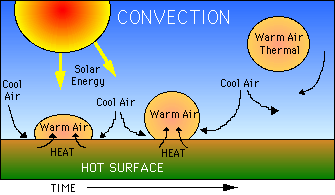Part: 1
Energy and Heat Transfer
Solar energy is the primary power source of everything on Earth, including
our atmosphere. This energy originates as radiant energy and is then transferred
into other forms, such as heat and light, following the First Law of Thermodynamics. Energy
can be transferred by several different means, including radiation,
conduction, convection, and advection.
Energy from the sun travels in the form of waves at the speed of light
(300,000 kilometers per second). These waves are absorbed when they come
in contact with surfaces. Because these waves have electrical and magnetic
attributes, they are referred to as electromagnetic waves. You feel these
electromagnetic waves as radiation when you lie on the beach and the sun
warms your skin and clothes. Radiative energy transfer (or radiation) is
the primary method of solar energy transfer to the earth's surface. The
next most common form of energy transfer is conduction.
When one molecule comes in contact with another, a tiny amount of energy
is transferred from one to the other. This form of molecular energy
transfer is known as conduction. Conduction, unlike radiation, involves
heat transfer. Heat is basically energy in the process of being
transferred due to a net difference in temperature between two molecules.
Temperature, on the other hand, is a measure of a molecule's kinetic energy. As
kinetic energy increases, so does heat; therefore, we use temperature
as a measure of heat for general purposes. Conduction is why the lit
burner on your stove feels very hot when you touch it. Another form of
energy transfer is convection.
Imagine an enormous kettle of cold water. In the center of the kettle is a
heat source (about 10 percent of the size of the kettle base). The water
is heated partially through conduction, but you would notice that the
water has hot and cold areas, not a uniform lukewarm body as one might
expect (if only conduction were involved). Plumes of warm water form
around the heat source and move upward because they are more buoyant (less
dense because they are warmer) . These rising thermal plumes, or thermals, are examples of convection. The
cooler water around the thermal then replaces the buoyant fluid and begins
to warm itself more quickly (it is now closer to the heat source).
Convection occurs in all fluids where there is uneven heating of the fluid.

Now, imagine the kettle as the atmosphere, and the heat source as the sun.
The same type of thermals form in the atmosphere due to uneven heating of
the earth's surface. These thermals rise into the atmosphere carrying not
just warmer air, but moisture, pollutants, and anything else the air can
hold. One way we describe air movement is by using air parcels. An air
parcel is a theoretical bounded volume of air. An ideal air parcel can expand and contract but cannot mix with the surrounding air. In other words, the volume of an ideal parcel is variable while its mass is constant. In
convection, air parcels that are warmer than their surroundings rise, and
water vapor in them may condense to form water droplets. This contributes
to the development of clouds. Click on the image to the right to view an animation of this cycle. Or, if you do not have a frames-compatible browser, you may follow this link to view the animation without frames.
There is also a similar type of heat
transfer in the horizontal direction -- advection.
The wind blows across North America generally from west to east. Wind is the movement of air and therefore, has the properties of the air of which it is composed. It can carry, or advect, warm or cold air to areas further east. It can also advect moisture, pollutants, etc. There are two main types of thermal advection - warm advection, which transfers warmer temperatures into a region, and cold advection, which transfers cooler temperatures into a region. Simply put, advection is the horizontal transfer of a property, like heat/temperature. As the air moves across an area, it transports the heat, moisture, pollutants, and pressure properties from that area.





 The Shodor
Education Foundation, Inc.
The Shodor
Education Foundation, Inc.